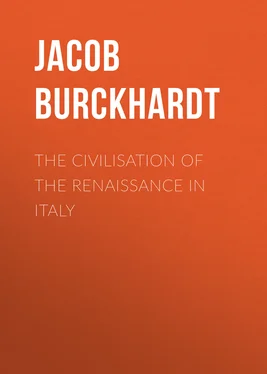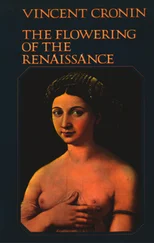Jacob Burckhardt - The Civilisation of the Renaissance in Italy
Здесь есть возможность читать онлайн «Jacob Burckhardt - The Civilisation of the Renaissance in Italy» — ознакомительный отрывок электронной книги совершенно бесплатно, а после прочтения отрывка купить полную версию. В некоторых случаях можно слушать аудио, скачать через торрент в формате fb2 и присутствует краткое содержание. Жанр: foreign_prose, История, foreign_edu, foreign_antique, на английском языке. Описание произведения, (предисловие) а так же отзывы посетителей доступны на портале библиотеки ЛибКат.
- Название:The Civilisation of the Renaissance in Italy
- Автор:
- Жанр:
- Год:неизвестен
- ISBN:нет данных
- Рейтинг книги:5 / 5. Голосов: 1
-
Избранное:Добавить в избранное
- Отзывы:
-
Ваша оценка:
- 100
- 1
- 2
- 3
- 4
- 5
The Civilisation of the Renaissance in Italy: краткое содержание, описание и аннотация
Предлагаем к чтению аннотацию, описание, краткое содержание или предисловие (зависит от того, что написал сам автор книги «The Civilisation of the Renaissance in Italy»). Если вы не нашли необходимую информацию о книге — напишите в комментариях, мы постараемся отыскать её.
The Civilisation of the Renaissance in Italy — читать онлайн ознакомительный отрывок
Ниже представлен текст книги, разбитый по страницам. Система сохранения места последней прочитанной страницы, позволяет с удобством читать онлайн бесплатно книгу «The Civilisation of the Renaissance in Italy», без необходимости каждый раз заново искать на чём Вы остановились. Поставьте закладку, и сможете в любой момент перейти на страницу, на которой закончили чтение.
Интервал:
Закладка:
The two most famous jesters about the middle of the fifteenth century were a priest near Florence, Arlotto (1483), for more refined wit (‘facezie’), and the court-fool of Ferrara, Gonnella, for buffoonery. We can hardly compare their stories with those of the Parson of Kalenberg and Till Eulenspiegel, since the latter arose in a different and half-mythical manner, as fruits of the imagination of a whole people, and touch rather on what is general and intelligible to all, while Arlotto and Gonnella were historical beings, coloured and shaped by local influences. But if the comparison be allowed, and extended to the jests of the non-Italian nations, we shall find in general that the joke in the French fabliaux , 368as among the Germans, is chiefly directed to the attainment of some advantage or enjoyment; while the wit of Arlotto and the practical jokes of Gonnella are an end in themselves, and exist simply for the sake of the triumph of production. (Till Eulenspiegel again forms a class by himself, as the personified quiz, mostly pointless enough, of particular classes and professions). The court-fool of the Este saved himself more than once by his keen satire and refined modes of vengeance. 369
The type of the ‘uomo piacevole’ and the ‘buffone’ long survived the freedom of Florence. Under Duke Cosimo flourished Barlacchia, and at the beginning of the seventeenth century Francesco Ruspoli and Curzio Marignolli. In Pope Leo X., the genuine Florentine love of jesters showed itself strikingly. This prince, whose taste for the most refined intellectual pleasures was insatiable, endured and desired at his table a number of witty buffoons and jack-puddings, among them two monks and a cripple; 370at public feasts he treated them with deliberate scorn as parasites, setting before them monkeys and crows in the place of savoury meats. Leo, indeed, showed a peculiar fondness for the ‘burla’; it belonged to his nature sometimes to treat his own favourite pursuits—music and poetry—ironically, parodying them with his factotum, Cardinal Bibbiena. 371Neither of them found it beneath him to fool an honest old secretary till he thought himself a master of the art of music. The Improvisatore, Baraballo of Gaeta, was brought so far by Leo’s flattery, that he applied in all seriousness for the poet’s coronation on the Capitol. On the anniversary of S. Cosmas and S. Damian, the patrons of the House of Medici, he was first compelled, adorned with laurel and purple, to amuse the papal guests with his recitations, and at last, when all were ready to split with laughter, to mount a gold-harnessed elephant in the court of the Vatican, sent as a present to Rome by Emanuel the Great of Portugal, while the Pope looked down from above through his eye-glass. 372The brute, however, was so terrified by the noise of the trumpets and kettle-drums, and the cheers of the crowd, that there was no getting him over the bridge of S. Angelo.
The parody of what is solemn or sublime, which here meets us in the case of a procession, had already taken an important place in poetry. 373It was naturally compelled to choose victims of another kind than those of Aristophanes, who introduced the great tragedian into his plays. But the same maturity of culture which at a certain period produced parody among the Greeks, did the same in Italy. By the close of the fourteenth century, the love-lorn wailings of Petrarch’s sonnets and others of the same kind were taken off by caricaturists; and the solemn air of this form of verse was parodied in lines of mystic twaddle. A constant invitation to parody was offered by the ‘Divine Comedy,’ and Lorenzo Magnifico wrote the most admirable travesty in the style of the ‘Inferno’ (‘Simposio’ or ‘I Beoni’). Luigi Pulei obviously imitates the Improvisatori in his ‘Morgante,’ and both his poetry and Bojardo’s are in part, at least, a half-conscious parody of the chivalrous poetry of the Middle Ages. Such a caricature was deliberately undertaken by the great parodist Teofilo Folengo (about 1520). Under the name of Limerno Pitocco, he composed the ‘Orlandino,’ in which chivalry appears only as a ludicrous setting for a crowd of modern figures and ideas. Under the name of Merlinus Coccajus he described the journeys and exploits of his phantastic vagabonds (also in the same spirit of parody) in half-Latin hexameters, with all the affected pomp of the learned Epos of the day. (‘Opus Macaronicorum’). Since then caricature has been constantly, and often brilliantly, represented on the Italian Parnassus.
About the middle period of the Renaissance a theoretical analysis of wit was undertaken, and its practical application in good society was regulated more precisely. The theorist was Gioviano Pontano. 374In his work on speaking, especially in the third and fourth books, he tries by means of the comparison of numerous jokes or ‘facetiæ’ to arrive at a general principle. How wit should be used among people of position is taught by Baldassar Castiglione in his ‘Cortigiano.’ 375Its chief function is naturally to enliven those present by the repetition of comic or graceful stories and sayings; personal jokes, on the contrary, are discouraged on the ground that they wound unhappy people, show too much honour to wrong-doers, and make enemies of the powerful and the spoiled children of fortune; 376and even in repetition, a wide reserve in the use of dramatic gestures is recommended to the gentleman. Then follows, not only for purposes of quotation, but as patterns for future jesters, a large collection of puns and witty sayings, methodically arranged according to their species, among them some that are admirable. The doctrine of Giovanni della Casa, some twenty years later, in his guide to good manners, is much stricter and more cautious; 377with a view to the consequences, he wishes to see the desire of triumph banished altogether from jokes and ‘burle.’ He is the herald of a reaction, which was certain sooner or later to appear.
Italy had, in fact, become a school for scandal, the like of which the world cannot show, not even in France at the time of Voltaire. In him and his comrades there was assuredly no lack of the spirit of negation; but where, in the eighteenth century, was to be found the crowd of suitable victims, that countless assembly of highly and characteristically-developed human beings, celebrities of every kind, statesmen, churchmen, inventors, and discoverers, men of letters, poets and artists, all of whom then gave the fullest and freest play to their individuality? This host existed in the fifteenth and sixteenth centuries, and by its side the general culture of the time had educated a poisonous brood of impotent wits, of born critics and railers, whose envy called for hecatombs of victims; and to all this was added the envy of the famous men among themselves. In this the philologists notoriously led the way—Filelfo, Poggio, Lorenzo Valla, and others—while the artists of the fifteenth century lived in peaceful and friendly competition with one another. The history of art may take note of the fact.
Florence, the great market of fame, was in this point, as we have said, in advance of other cities. ‘Sharp eyes and bad tongues’ is the description given of the inhabitants. 378An easy-going contempt of everything and everybody was probably the prevailing tone of society. Macchiavelli, in the remarkable prologue to his ‘Mandragola,’ refers rightly or wrongly the visible decline of moral force to the general habit of evil speaking, and threatens his detractors with the news that he can say sharp things as well as they. Next to Florence comes the Papal court, which had long been a rendezvous of the bitterest and wittiest tongues. Poggio’s ‘Facetiæ’ are dated from the Chamber of Lies ( bugiale ) of the apostolic notaries; and when we remember the number of disappointed place-hunters, of hopeless competitors and enemies of the favourites, of idle, profligate prelates there assembled, it is intelligible how Rome became the home of the savage pasquinade as well as of more philosophical satire. If we add to this the wide-spread hatred borne to the priests, and the well-known instinct of the mob to lay any horror to the charge of the great, there results an untold mass of infamy. 379Those who were able protected themselves best by contempt both of the false and true accusations, and by brilliant and joyous display. 380More sensitive natures sank into utter despair when they found themselves deeply involved in guilt, and still more deeply in slander. 381In course of time calumny became universal, and the strictest virtue was most certain of all to challenge the attacks of malice. Of the great pulpit orator, Fra Egidio of Viterbo, whom Leo made a cardinal on account of his merits, and who showed himself a man of the people and a brave monk in the calamity of 1527, 382Giovio gives us to understand that he preserved his ascetic pallor by the smoke of wet straw and other means of the same kind. Giovio is a genuine Curial in these matters. 383He generally begins by telling his story, then adds that he does not believe it, and then hints at the end that perhaps after all there may be something in it. But the true scape-goat of Roman scorn was the pious and moral Adrian VI. A general agreement seemed to be made to take him only on the comic side. Adrian had contemptuously referred to the Laöcoon group as ‘idola antiquorum,’ had shut up the entrance to the Belvedere, had left the works of Raphael unfinished, and had banished the poets and players from the court; it was even feared that he would burn some ancient statues to lime for the new church of St. Peter. He fell out from the first with the formidable Francesco Berni, threatening to have thrown into the Tiber not, as people said, 384the statue of Pasquino, but the writers of the satires themselves. The vengeance for this was the famous ‘Capitolo’ against Pope Adriano, inspired not exactly by hatred, but by contempt for the comical Dutch barbarian; 385the more savage menaces were reserved for the cardinals who had elected him. The plague, which then was prevalent in Rome, was ascribed to him; 386Berni and others 387sketch the environment of the Pope—the Germans by whom he was governed 388—with the same sparkling untruthfulness with which the modern feuilletoniste turns black into white, and everything into anything. The biography which Paolo Giovio was commissioned to write by the Cardinal of Tortosa, and which was to have been a eulogy, is for any one who can read between the lines an unexampled piece of satire. It sounds ridiculous—at least for the Italians of that time—to hear how Adrian applied to the Chapter of Saragossa for the jaw-bone of St. Lambert; how the devout Spaniards decked him out till he looked ‘like a right well-dressed Pope;’ how he came in a confused and tasteless procession from Ostia to Rome, took counsel about burning or drowning Pasquino, would suddenly break off the most important business when dinner was announced; and lastly, at the end of an unhappy reign, how he died of drinking too much beer—whereupon the house of his physician was hung with garlands by midnight revellers, and adorned with the inscription, ‘Liberatori Patriæ S. P. Q. R.’ It is true that Giovio had lost his money in the general confiscation of public funds, and had only received a benefice by way of compensation because he was ‘no poet,’ that is to say. no pagan. 389But it was decreed that Adrian should be the last great victim. After the disaster which befell Rome in 1527, slander visibly declined along with the unrestrained wickedness of private life.
Читать дальшеИнтервал:
Закладка:
Похожие книги на «The Civilisation of the Renaissance in Italy»
Представляем Вашему вниманию похожие книги на «The Civilisation of the Renaissance in Italy» списком для выбора. Мы отобрали схожую по названию и смыслу литературу в надежде предоставить читателям больше вариантов отыскать новые, интересные, ещё непрочитанные произведения.
Обсуждение, отзывы о книге «The Civilisation of the Renaissance in Italy» и просто собственные мнения читателей. Оставьте ваши комментарии, напишите, что Вы думаете о произведении, его смысле или главных героях. Укажите что конкретно понравилось, а что нет, и почему Вы так считаете.












